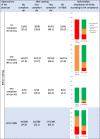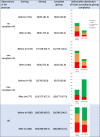Impact of a training strategy on improving compliance of hand hygiene and gloving during the placement of a short peripheral venous catheter: the multicentre study CleanHand4
- PMID: 37803431
- PMCID: PMC10559517
- DOI: 10.1186/s12909-023-04727-x
Impact of a training strategy on improving compliance of hand hygiene and gloving during the placement of a short peripheral venous catheter: the multicentre study CleanHand4
Abstract
Background: Patients who have short peripheral venous catheters (PVC) face an elevated risk of developing bloodstream infections. Preventing catheter-related infections relies on implementing multiple measures, including practicing proper hand hygiene (HH) during catheter placement.
Methods: We conducted a four-part study: (1) an evaluation of HH practices through direct observation of PVC placements, coupled with the study of the microbial flora of the HCWs fingers just before the placement; (2) the development of an educational tool based on the collected observational and microbiological data; (3) the training to the HCWs observed during the first part, using this tool; and (4) the subsequent observation of the trained HCWs to measure the impact of the training on practice improvement.
Results: Compliant HH was observed in 23.5% of the 647 HCWs observed during PVC placement before training. The microbiological study revealed fewer pathogens on the fingertips of the HCWs practicing compliant HH compared other HCWs (2.6 vs 11,7%; p = 0.003). The comparison of practices before and after training, assessed among 180 HCWs, showed an increase in the proportion of HCWs performing compliant HH (25.0 vs 63.2%; p < 0.001).
Conclusions: Training HCWs using our educational tool, which combines reminders of best practices and risk factors associated with PVC-related infections, engaging HCWs (presentation of practice evaluation), identifying professionals deviating from best practices (simulation videos), and objectively assessing fingertip contamination (microbiological study), significantly improved compliance with HH gestures and glove usage. We encourage infection control teams to utilize this tool to raise awareness among HCWs responsible for PVC placement about the risk of infection associated inadequate hand hygiene.
Keywords: Asepsis; Gloving; Hand hygiene; Improvement of practices; Short peripheral venous catheters.
© 2023. BioMed Central Ltd., part of Springer Nature.
Conflict of interest statement
The authors declare no competing interests.
Figures
References
-
- Hajjar J, Verdeil X. Pose et entretien des cathéters veineux périphériques. 2007.
Publication types
MeSH terms
LinkOut - more resources
Full Text Sources
Medical



